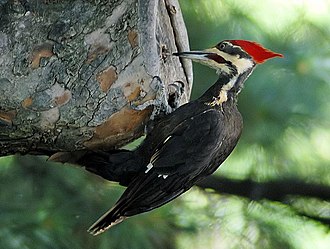- Woodpeckers are a group of birds known for their unique ability to peck and drum on trees.
- There are over 200 species of woodpeckers worldwide, found in various habitats ranging from forests to deserts.
- Woodpeckers have specially adapted skulls and strong beaks that allow them to peck at tree trunks without injuring themselves.
- They use their beaks to drill holes in trees to search for food, such as insects, larvae, and sap.
- Woodpeckers have long, barbed tongues that they can extend to extract insects from crevices in the wood.
- They have strong, chisel-like bills that can create drumming sounds as they peck on trees for communication and territorial displays.
- Woodpeckers have unique anatomical features, including stiff tail feathers and strong feet with curved claws for gripping tree trunks.
- They can drum on trees at a rapid rate, with some species reaching up to 20 drumming strikes per second.
- Woodpeckers play a vital role in forest ecosystems by controlling insect populations and creating cavities that serve as nesting sites for other birds and animals.
- They have a specialized shock-absorbing system in their heads that helps protect their brains from the impact of pecking.
- Woodpeckers have strong neck muscles that allow them to move their heads rapidly and repeatedly while pecking.
- They have excellent hearing, capable of detecting insect movements and vibrations within trees.
- Woodpeckers can be found on every continent except Antarctica.
- They have unique coloring patterns, including a variety of black, white, and brown markings, which help them blend into their surroundings.
- Woodpeckers communicate through a combination of drumming, calls, and displays, with different species having distinct vocalizations.
- They are skilled climbers, using their strong beaks and claws to grip tree trunks vertically or even upside down.
- Woodpeckers have zygodactyl feet, with two toes facing forward and two toes facing backward, providing enhanced stability while climbing.
- They excavate nest cavities in trees, often using the same cavity for multiple breeding seasons.
- Woodpeckers have a unique flight pattern characterized by undulating flight, interspersed with quick bursts of flapping.
- They have territorial behaviors, defending their nesting sites and foraging areas from other woodpeckers.
- Woodpeckers have been known to drum on various surfaces other than trees, including metal gutters, poles, and even man-made structures.
- They have been observed using tools, such as sticks or twigs, to probe for insects in crevices that are too narrow for their beaks.
- Woodpeckers have adaptations that help protect their brains from the forces of pecking, including a spongy bone structure and cerebrospinal fluid cushioning.
- They have a unique tongue structure, with barbs and sticky saliva that aid in capturing insects.
- Woodpeckers have been found to have specialized bacteria in their gut that help them digest the cellulose found in wood.
- They are monogamous, typically forming long-term pair bonds with their mates.
- Woodpeckers have a drumming ritual during courtship, where males create rhythmic drumming sounds to attract females.
- They have been known to cache food, such as acorns or seeds, by wedging them into crevices or tree bark for future consumption.
- Woodpeckers are highly territorial and will defend their nesting sites and food sources from intruders.
- They have a unique ability to drum on resonant surfaces, creating loud and distinctive sounds that can carry over long distances.
- Woodpeckers are important indicators of forest health, as their presence indicates the availability of insect populations and the overall well-being of the ecosystem.
- They have been known to use their drumming sounds as a form of communication, attracting mates and warning off rivals.
- Woodpeckers have stiff tail feathers that act as a brace, providing stability and support while clinging to vertical surfaces.
- They have a diverse range of beak shapes and sizes, each suited for different foraging techniques and feeding preferences.
- Woodpeckers have been studied for their ability to withstand high deceleration forces, inspiring innovations in helmet and concussion research.
- They are cavity nesters, excavating holes in trees for nesting and roosting purposes.
- Woodpeckers are capable of pecking at speeds of up to 20 times per second.
- They have a unique method of communication known as drumming, which involves rapidly striking their bills against a resonating surface.
- Woodpeckers have excellent spatial memory, enabling them to remember the location of potential food sources and nesting sites.
- They have a distinctive “drum roll” call that can be heard during territorial disputes or courtship displays.
- Woodpeckers have been observed using their drumming sounds to attract potential mates or establish their presence in an area.
- They have a strong sense of hearing, capable of detecting insect movements and even the sound of wood-boring beetle larvae within trees.
- Woodpeckers have been found to use different drumming patterns for various purposes, such as attracting mates or establishing territory boundaries.
- They have a long lifespan compared to many other bird species, with some woodpeckers living up to 15 years or more.
- Woodpeckers have been featured in various cultural references, such as literature, cartoons, and folklore, often symbolizing perseverance and resilience.
- They are highly adaptable and can be found in a wide range of habitats, including forests, woodlands, savannas, and even urban areas.
- Woodpeckers have specialized feathers called “powder down” that help repel water and keep their feathers in good condition.
- They have been observed using drumming as a means of communication within their own species, signaling information such as territory boundaries or food availability.
- Woodpeckers have a unique tongue structure, with a long, barbed tongue that wraps around the back of their skull to provide additional support while pecking.
- They are fascinating birds that captivate the interest of birdwatchers and nature enthusiasts alike, with their distinctive behaviors, adaptations, and important ecological role in forest ecosystems.
Facebook Comments


































